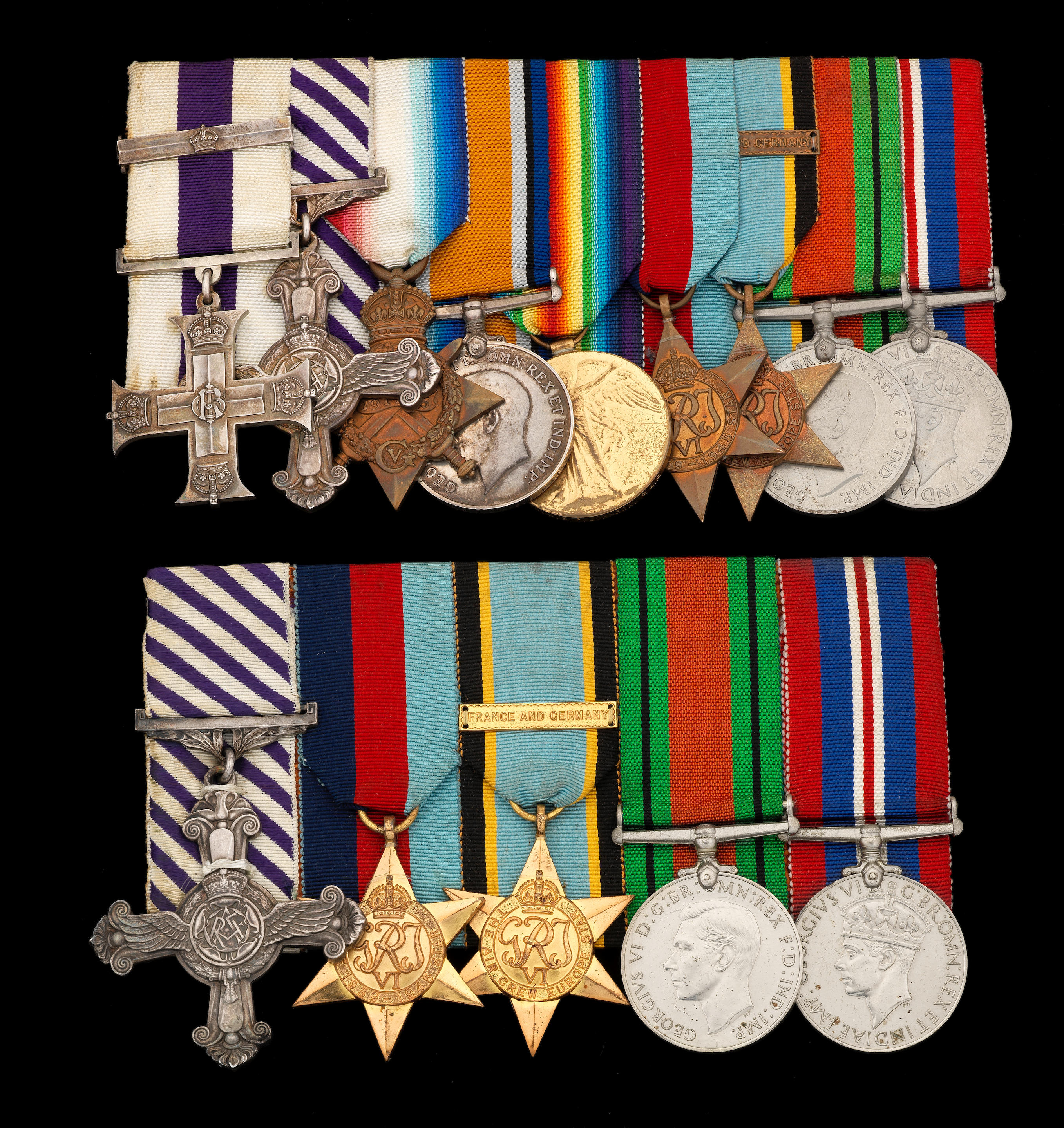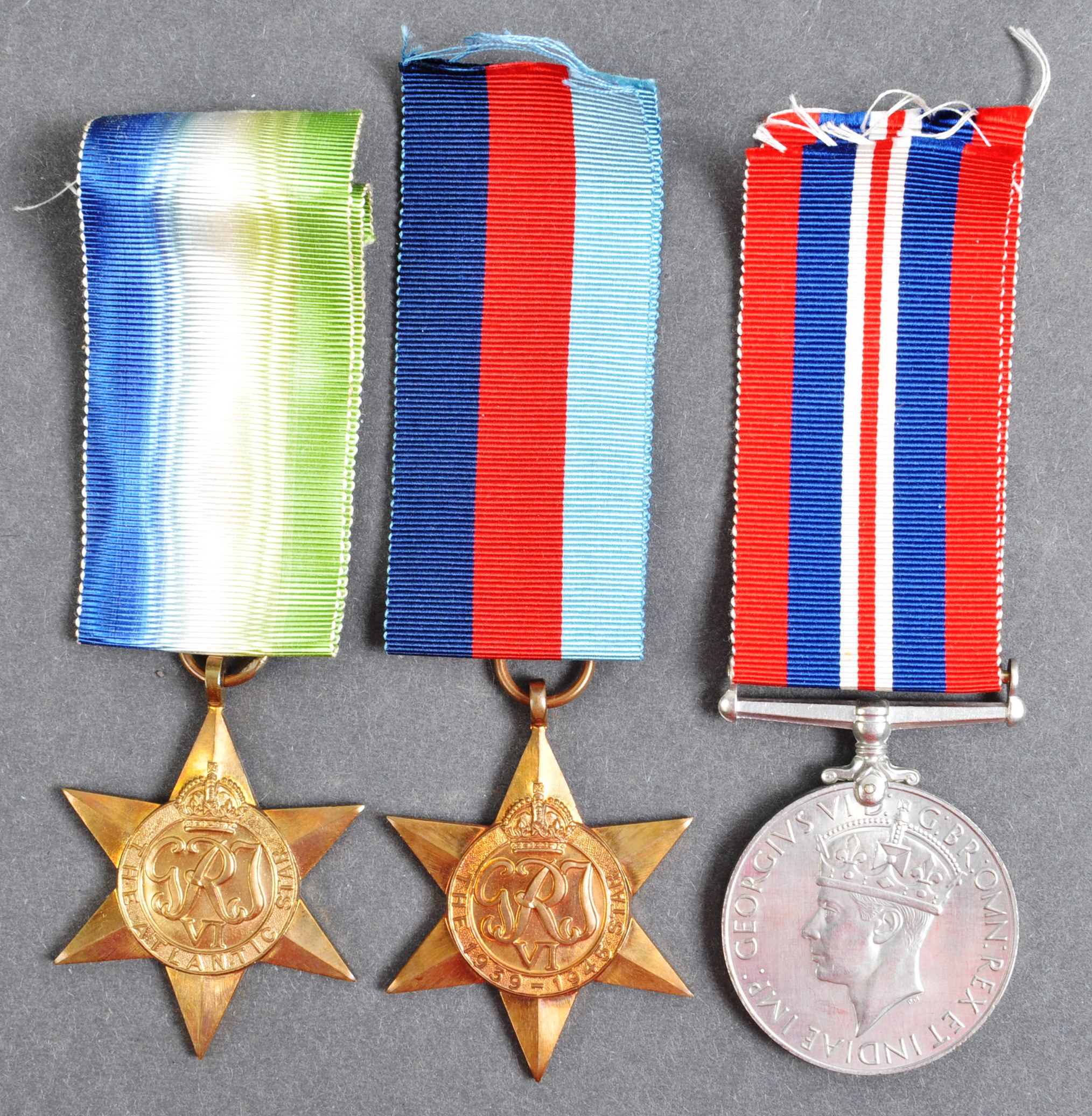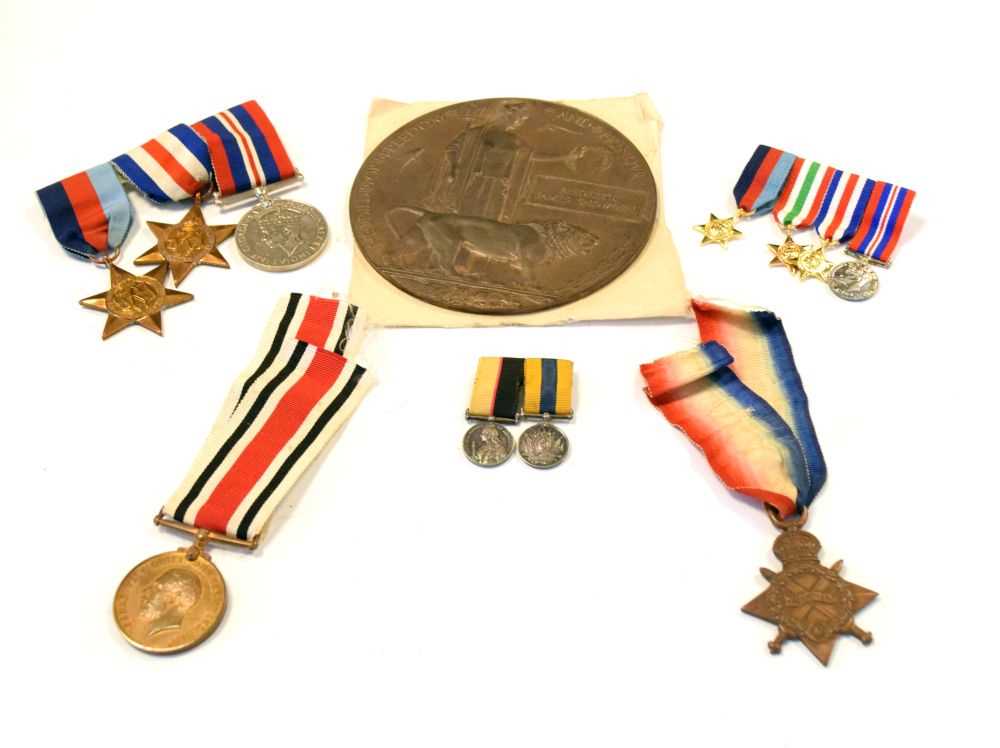A Second World War campaign group of six awarded to Petty Officer J. F. Moore, Royal Navy Lent to the Royal New Zealand Navy in the mid-1930s, Moore enjoyed a decade of service in the cruiser H.M.N.Z.S. Leander, so enjoyable that when he came ashore for a final time in May 1948, he opted to settle in New Zealand In the interim, Leander had witnessed extensive action in the Red Sea, Indian Ocean and Pacific, her guns claiming the Italian raider Ramb 1 in February 1941; she also - somehow - survived a devastating torpedo strike care of "The Tokyo Express" in July 1943 1939-45 Star; Africa Star; Pacific Star; Defence and War Medals 1939-45; Royal Navy L.S. & G.C., G.VI.R., 1st issue (J. 110875 J. F. Moore, A./P.O., H.M.S. Leander), good very fine (6) John Francis Moore was born in Hull on 30 April 1908 and entered the Royal Navy as a Boy 2nd Class in July 1924. Having seen action in H.M.S. Caradoc during the Chinese Civil War in the 1920s, he was loaned to the New Zealand Navy - soon to be the Royal New Zealand Navy - and joined the cruiser Leander in April 1935. Remarkably, he would remain similarly employed until April 1945, gaining advancement to Petty Officer and being awarded his L.S. & G.C. Medal in April 1941. Red Sea and Indian Ocean It had been intended the Leander would serve in the Mediterranean, but this was changed shortly after her arrival at Alexandria and she joined the East Indies Station at Port Sudan on 4 June 1940, embarking the Admiral Commanding the Red Sea Force. The functions of this force were convoy escort and the protection of shipping in the Red Sea and Aden area. June proved to be an eventful month, Leander experiencing air attacks and, although not hit, she did suffer splinter damage from near misses; she destroyed a damaged Italian submarine south of the enemy naval base at Massawa, Eritrea on the 27th. On 21 October, Leander and her consorts engaged two Italian destroyers which threatened a convoy bound from Massewa; the destroyer Kimberley sank one of them but was damaged herself and taken in tow by Leander. The pursuit of enemy raiders In January 1941, Leander joined the Eastern Fleet, based at Colombo. Here again the main duty was the protection of shipping. However, convoy escort duty was varied by the need to seek out enemy raiders known to be in the Indian Ocean. The first of these patrols commenced on 24 January, when a distress signal from the British steamer Mandasor was received. Leander and H.M.A.S. Canberra searched the area for what was later known to be the raider Atlantis, but without success. On 27 February 1941, Leander sighted a ship at 10:27a.m., which proved to be the Italian Raider Ramb 1. Armed with four 4.7-inch guns, the Italian ship was flying the Red Ensign when she was intercepted. She changed it for the Italian flag, but after five salvoes from the Leander, she struck her flag and surrendered. She sank after burning fiercely for nearly an hour. Eleven officers and 89 men, including five wounded, were picked up. Patrolling with H.M.A.S. Canberra in the following month, Leander was in a supporting role when the former sank the German ship Coburg and the captured tanker Kitty Brovig, which was being used to fuel enemy raiders. Similarly, she was part of the patrolling forces when the H.M.S. Cornwall sank the raider Penguin. Having then been deployed to the Mediterranean, where she saw action against the Vichy French - and once again came under air attack - Leander returned to New Zealand in September 1941. The Solomon Islands and "The Tokyo Express" In early 1942, following Japan's entry into the war, Leander was deployed to the Pacific, where she undertook convoy escorts, latterly as part of Task Force 16. Having then returned to New Zealand for repairs, she was back on station by March 1943 and, in June, joined Task Force 18 at Espiritu Santo in the New Hebrides. At this time the Japanese were attempting to reinforce and supply their forward positions in the Solomon Islan
A Second World War campaign group of six awarded to Petty Officer J. F. Moore, Royal Navy Lent to the Royal New Zealand Navy in the mid-1930s, Moore enjoyed a decade of service in the cruiser H.M.N.Z.S. Leander, so enjoyable that when he came ashore for a final time in May 1948, he opted to settle in New Zealand In the interim, Leander had witnessed extensive action in the Red Sea, Indian Ocean and Pacific, her guns claiming the Italian raider Ramb 1 in February 1941; she also - somehow - survived a devastating torpedo strike care of "The Tokyo Express" in July 1943 1939-45 Star; Africa Star; Pacific Star; Defence and War Medals 1939-45; Royal Navy L.S. & G.C., G.VI.R., 1st issue (J. 110875 J. F. Moore, A./P.O., H.M.S. Leander), good very fine (6) John Francis Moore was born in Hull on 30 April 1908 and entered the Royal Navy as a Boy 2nd Class in July 1924. Having seen action in H.M.S. Caradoc during the Chinese Civil War in the 1920s, he was loaned to the New Zealand Navy - soon to be the Royal New Zealand Navy - and joined the cruiser Leander in April 1935. Remarkably, he would remain similarly employed until April 1945, gaining advancement to Petty Officer and being awarded his L.S. & G.C. Medal in April 1941. Red Sea and Indian Ocean It had been intended the Leander would serve in the Mediterranean, but this was changed shortly after her arrival at Alexandria and she joined the East Indies Station at Port Sudan on 4 June 1940, embarking the Admiral Commanding the Red Sea Force. The functions of this force were convoy escort and the protection of shipping in the Red Sea and Aden area. June proved to be an eventful month, Leander experiencing air attacks and, although not hit, she did suffer splinter damage from near misses; she destroyed a damaged Italian submarine south of the enemy naval base at Massawa, Eritrea on the 27th. On 21 October, Leander and her consorts engaged two Italian destroyers which threatened a convoy bound from Massewa; the destroyer Kimberley sank one of them but was damaged herself and taken in tow by Leander. The pursuit of enemy raiders In January 1941, Leander joined the Eastern Fleet, based at Colombo. Here again the main duty was the protection of shipping. However, convoy escort duty was varied by the need to seek out enemy raiders known to be in the Indian Ocean. The first of these patrols commenced on 24 January, when a distress signal from the British steamer Mandasor was received. Leander and H.M.A.S. Canberra searched the area for what was later known to be the raider Atlantis, but without success. On 27 February 1941, Leander sighted a ship at 10:27a.m., which proved to be the Italian Raider Ramb 1. Armed with four 4.7-inch guns, the Italian ship was flying the Red Ensign when she was intercepted. She changed it for the Italian flag, but after five salvoes from the Leander, she struck her flag and surrendered. She sank after burning fiercely for nearly an hour. Eleven officers and 89 men, including five wounded, were picked up. Patrolling with H.M.A.S. Canberra in the following month, Leander was in a supporting role when the former sank the German ship Coburg and the captured tanker Kitty Brovig, which was being used to fuel enemy raiders. Similarly, she was part of the patrolling forces when the H.M.S. Cornwall sank the raider Penguin. Having then been deployed to the Mediterranean, where she saw action against the Vichy French - and once again came under air attack - Leander returned to New Zealand in September 1941. The Solomon Islands and "The Tokyo Express" In early 1942, following Japan's entry into the war, Leander was deployed to the Pacific, where she undertook convoy escorts, latterly as part of Task Force 16. Having then returned to New Zealand for repairs, she was back on station by March 1943 and, in June, joined Task Force 18 at Espiritu Santo in the New Hebrides. At this time the Japanese were attempting to reinforce and supply their forward positions in the Solomon Islan















Try LotSearch and its premium features for 7 days - without any costs!
Be notified automatically about new items in upcoming auctions.
Create an alert